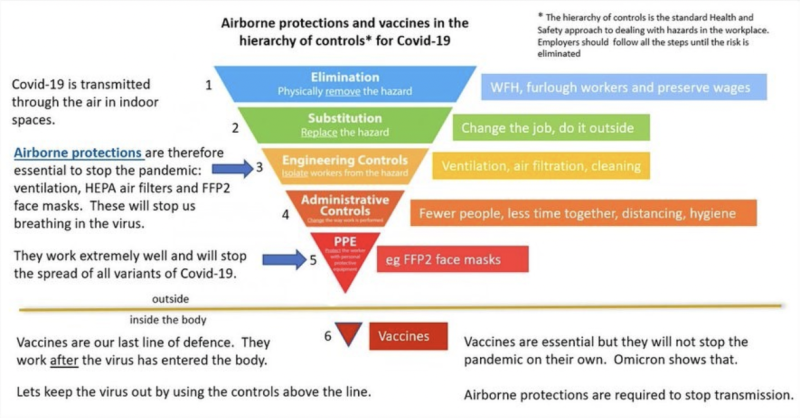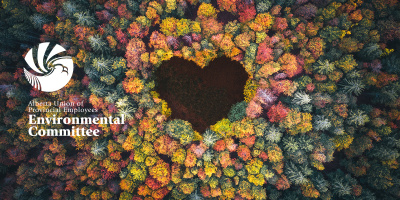Joint Statement from Alberta unions calling for action from government
Alberta’s largest unions call for temporary circuit-breaker measures to stop Omicron
Jan 12, 2022
Joint Statement from Alberta Unions

With recently leaked reports, now confirmed by Alberta Health Services (AHS), showing that our health care system is about to be overwhelmed by the double-pronged reality of sky-rocketing hospital admissions and unprecedented staff shortages, we, the leaders of Alberta’s largest unions and labour organizations, demand that the Kenney government immediately implement temporary circuit-breaker measures to break the chains of transmission that are driving the Omicron Wave of the pandemic.
We make this call reluctantly and with great frustration, but believe we have been left with no alternatives because the pandemic in Alberta is out of control; workplaces and schools are unsafe; and our health care system and our health care workers are already being overwhelmed.
The circuit-breaker measures we’re proposing should include prohibiting large gatherings, including concerts and sporting events; closing restaurants and bars to in-person dining; shutting down movie theatres and casinos; moving churches and other houses of worship online; moving all university and colleges classes online; closing gyms and suspending recreational sports; and, as a very last resort, moving all students in K-12 schools to online learning. Only essential services should continue to operate while these emergency measures are in place and income supports should, once again, be provided to workers and businesses who are impacted.
Like all Albertans, we would have preferred to keep our economy open and students in classrooms. Moreover, we believe circuit-breaker measures could have been avoided if the Kenney government had listened to the World Health Organization in early December when it said that vaccine-only strategies would not be sufficient to deal with the highly-transmissible Omicron variant.
Sadly, as the result of the Kenney government’s refusal to even consider scientifically-supported mitigation measures to reduce transmission in indoor environments – such as requiring and providing N-95 or KN-95 masks to all workers and students; and requiring indoor air quality monitoring and air filtration – the opportunity to get ahead of the fifth wave has been lost. As a result, we are now left with a circuit-breaker as the only possible tool to counter the relentless and unbending math of the virus’ exponential growth.
To put it another way, because of the government’s dangerous political pandering and its willful policy negligence, we now have only two options to choose from: temporary circuit-breaker measures, on one hand, or a health care system collapse and rising disease, disability and death, on the other. We, along with what we expect would be a clear majority of Albertans, choose temporary circuit-breaker measures as the lesser of two evils.
In addition to calling for circuit-breaker measures, we further demand that the government acknowledge the abject failure of its “Learn-To-Live-It” strategy and start taking actions that will better protect the health and safety of workers, students and the broader public during this and all future waves of the pandemic.
Specifically, we believe that the government needs to do the following things:
- Accept that we’re still in a pandemic - Wishing for COVID to become an endemic disease like the flu or a cold will not make it so. The government needs to stop pretending. The virus is not influenced by their political rhetoric or spin.
- Acknowledge that COVID is airborne - There is now a global scientific consensus that COVID particles can hang in the air for hours like cigarette smoke in indoor environments. Given that the hazard is in the air, we need counter measures that acknowledge that fact.
- Upgrade masks to respirators - One of the best ways to break the chains of transmission with an airborne virus like COVID is to upgrade our masks. Experts have concluded that surgical masks and cloth masks just don’t cut it. The government should mandate the use of better-fitting N-95 or KN-95 masks in all indoor environments (not just a narrow range of health care settings), especially when case counts begin to mount. And they should provide these higher-quality mask-respirators to citizens, workers and students, free of charge.
- Monitor and filter indoor air - One of the first and most important innovations of modern public health was to start monitoring and regulating the safety of the water we drink to stop the spread of water-born diseases like cholera. COVID has demonstrated that we need to take a similar approach with the air we breathe in indoor environments to stop the spread of air-borne diseases. In the short term, we demand that our governments start mandating and supporting the use of air quality monitors, upgraded HVAC systems and portable HEPA filters. In the longer term, we demand new standards for air quality in all indoor work environments and public spaces, including schools and all workplaces.
- Adopt the Precautionary Principle - In the wake of the deadly SARS outbreak in Ontario hospitals in 2003, a special panel was struck to learn lessons that could be useful in future epidemics and pandemics. The resulting SARS Commission report, released in 2006, included five volumes and thousands of pages. One of the key recommendations was that all future governments facing pandemics should embrace the Precautionary Principle, which says that public health authorities should implement all reasonable safety measures, even if all the science related to those measures is not yet completely settled. In the context of COVID, that means we failed when we waited too long to support mask and vaccine mandates. And it means we’re failing now by making excuses to not mandate N-95s and air filtration. During pandemics, it is always better to do too much to protect citizens, rather than too little. Here in Alberta, we have consistently been doing too little.
- Use the lens of Workplace Safety - In addition to recommending the use of the Precautionary Principle, the SARS Commission also recommended that governments, employers and public health authorities look at pandemics through the lens of workplace health and safety, in addition to through the lens of public health. One of the most useful tools used by workplace health and safety experts is something called the Hierarchy of Controls. When adapted for the COVID pandemic, it illustrates just how many opportunities to control the pandemic have been overlooked by the Kenney government. This needs to change.
- Re-institute “Test-Trace-Isolate” – For most of the pandemic, the mantra of public health experts has been “Test-Trace-Isolate.” Experience from around the world has shown that this is a strategy that works. But here in Alberta, the Kenney government effectively abandoned tracing last summer. On New Year’s Eve, they dramatically (and recklessly) scaled back isolation, from ten days to five. And now, they are restricting access to PCR tests that used to provide crucial data for both policy makers and health care workers. This is a big problem because, as management gurus have always said, you can’t manage things you can’t measure. One of the only ways to ensure that we never face another wave like this one is to bring back “Test-Trace-Isolate” – without it, we’re basically resigning ourselves to endless rounds of infections and virus mutations. This is completely unacceptable.
- Reverse Dangerous Decisions – The recent decisions to end most testing, move to a 5-day isolation period and allow employers to “self-designate” as essential services in order to get around even the shortened 5-day isolation period aren’t just examples of wrong-headed policy – they are dangerous. Unless the goal is to actually infect the whole population (which would be outrageous, both from a medical and moral perspective) these policies are bound to backfire. Forcing people back to work when they’re still infectious will simply lead to more infections – and a longer, more brutal fifth wave. Clearly this is in no one’s best interest.
- Acknowledge "Long-COVID" – Despite what our Premier has said in the past, COVID is not a respiratory disease like the flu. Instead, it is a disease that can attack multiple systems of the body, including the lungs, the brain, the heart, the kidneys and the circulatory system. Recent studies have estimated that as many as half a million Canadians are already suffering from long-term disabilities cause by the damage that COVID did to their bodies. With that in mind, governments need to understand that inaction on COVID could lead to disability among hundreds of thousand of citizens, including children. The reality of “long-COVID” needs to be factored into all decisions the government makes about the pandemic.
- Establish On-Site Booster Clinics in workplaces – By itself, vaccination is not enough to end the pandemic, but it is the most essential part of the strategy. However, even two years into the pandemic, there are still huge inequities and roadblocks when it comes to access. Lower-wage workers and new immigrants often have difficulty getting time off to go to a clinic. Language is often a barrier. And Alberta has the lowest rates of vaccination among 5 to 11-year-olds in Canada. To help address these issues, the government should set up vaccination and booster clinics in workplaces (meat packing plants, oil sands work camps, etc.) and in schools.
- Implement paid Sick Leave for all – The pandemic has exposed many holes in Canada’s social and economic policy framework. One of the most glaring holes has to do with sick leave. Public health authorities repeatedly tell people to stay home when they’re sick. But the reality is that about two-thirds of Alberta workers don’t have access to paid sick leave – so many of them feel they have no choice but to go to work even if they’re not feeling well. As a matter of public health and workplace safety, 10 days of employer-paid sick leave must be made available to all workers.
Our final message for Premier Jason Kenney and members of his government is this: Workers, students, seniors and all other Albertans are facing unacceptable levels of risk as a result of the unchecked Omicron wave. We are also facing the prospect of the imminent collapse of our provincial health care system. Even if your only concern is the economy, the reality is that you can’t run a healthy economy without healthy workers and confident consumers – and you won’t have either of these until this wave of the pandemic is brought under control. That’s why we are collectively calling for the immediate introduction of circuit-breaker measures, followed by the implementation of the ten other steps we’ve outlined above. It’s too late to avoid the fifth wave; but it’s not too late to save lives and protect our health care system and our economy.
Signed:
Gil McGowan, President, Alberta Federation of Labour (AFL)
Guy Smith, President, Alberta Union of Provincial Employees (AUPE)
Heather Smith, President, United Nurses of Alberta (UNA)
Jason Schilling, President, Alberta Teachers Association (ATA)
Tom Hesse, President, United Food and Commercial Workers (UFCW), Local 401
Mike Parker, President, Health Sciences Association of Alberta (HSAA)
Rory Gill, President, Canadian Union of Public Employees, (CUPE), Alberta Division
Jillian Pratt, President, Non-Academic Staff Association (NASA)
Ken Heather, President, Alberta College and Institutes Faculty Association (ACIFA)
Gavin McGarrigle, Western Regional Director, Unifor
News Category
- Member update

